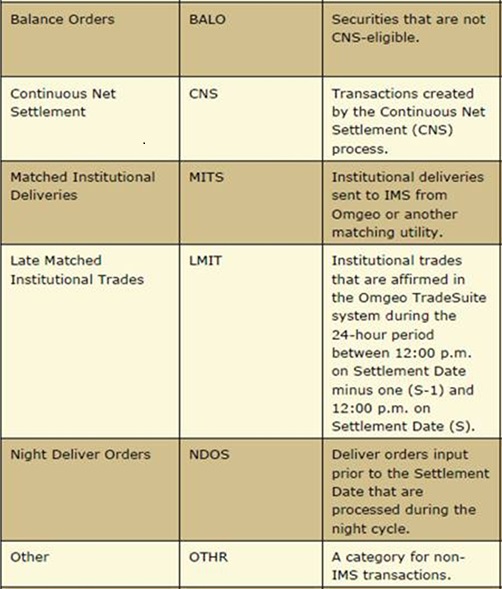Profiles
Profiles allow a participant to set rules to instruct DTC when and in what order deliveries from its inventory should be introduced for settlement. There are four main profile types:
- Authorization: allows a participant to control which deliver orders are submitted for settlement on settlement date. There are two authorization modes – passive and active. A passive setting authorizes transactions automatically, with no Participant intervention required. An active setting requires authorization from the Participant prior to settlement.
- Submission Order: allows a Participant to control the order in which DTC introduces transactions of the Participant for night-cycle processing. If not set otherwise, the order is:
- Reintroduced Drops
- Continuous Net Settlement (CNS)
- Automated Customer Account Transfer Service (ACATS). A delivering participant can choose to have its non-CNS-eligible ACATS deliveries sent from NSCC to IMS rather than input them directly.
- Matched Institutional Trades
- Balance Orders. A delivering participant can choose to have its non-CNS eligible Balance Order deliveries sent from NSCC to IMS rather than input them directly.
- Night Delivery Orders
Participants preferring a different submission order may, for a fee, instruct DTC to customize this order to fit their needs. For example, participants can instruct DTC to introduce their Auto DO ACATS from NSCC before their CNS deliveries.
- Recycle Order: allows a participant to instruct DTC in which order pending transactions are attempted throughout the day. There are 3 key delivery profiles: green, yellow and red.
- A green profile attempts to process deliveries in the order directed per the profile created by the participant, processes transactions if position is available and risk management controls can be satisfied for both the receiver and deliverer.
- A yellow profile will only process deliveries in the order specified by the Participant, including reserving position for deliveries pending for a receiver’s controls.
- A red profile does not process deliveries unless instructed by the deliverer, although deliveries are queued based upon the profile created.
- Reintroduced Drops: allows a participant to instruct DTC to attempt automatically to redeliver a transaction that did not process (i.e., dropped transaction) due to insufficient position or risk management controls.
Transactions
IMS handles a variety of processing flows for the different transactions that enter DTC’s settlement system. Transaction types are high-level categories of different deliver order types – e.g., institutional deliveries, night-deliver orders – as well as transaction types that are not deliver orders, such as segregations, memo segregations, etc. All non-deliver-order transactions are designated as “OTHR” transaction type in IMS. Below is a list of IMS transaction types, their IMS code and a brief description:

Transaction States
As transactions move through various stages of IMS -- profiles are applied, commands are entered, processing events take place – they are assigned to the appropriate IMS state. Each time the status of a transaction changes, it is assigned a new state, allowing a user to track transaction status. While there are several states a transaction can move in and out of once in IMS, the majority of transactions follow a common flow. Transactions enter IMS in an “Unprocessed” state; most become “Authorized” and ultimately are sent to settlement where they are “Made” or “Dropped.”